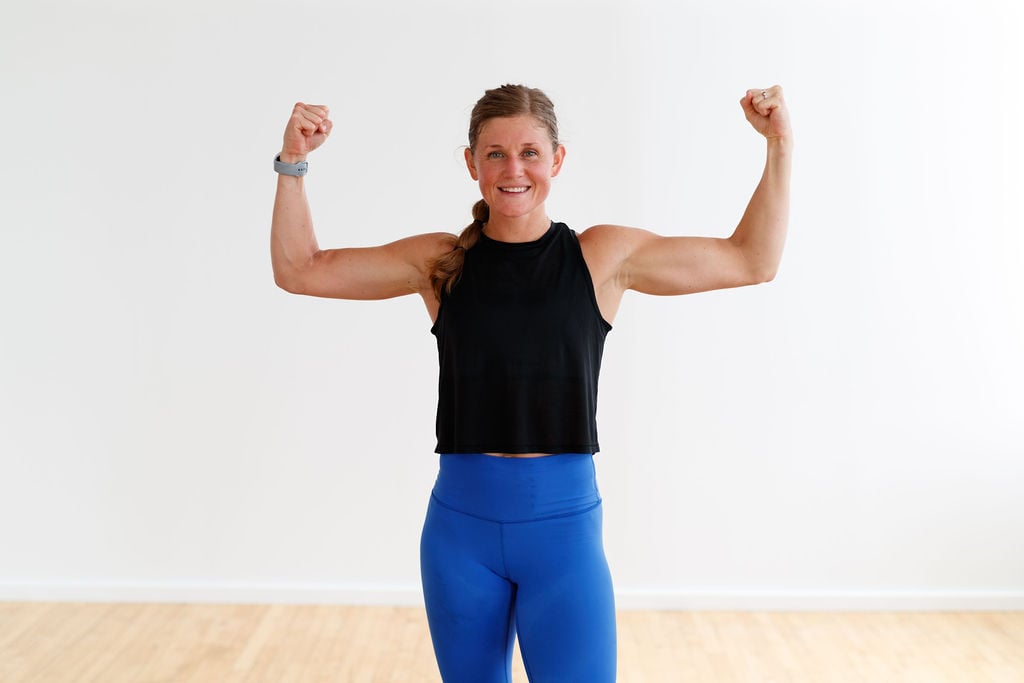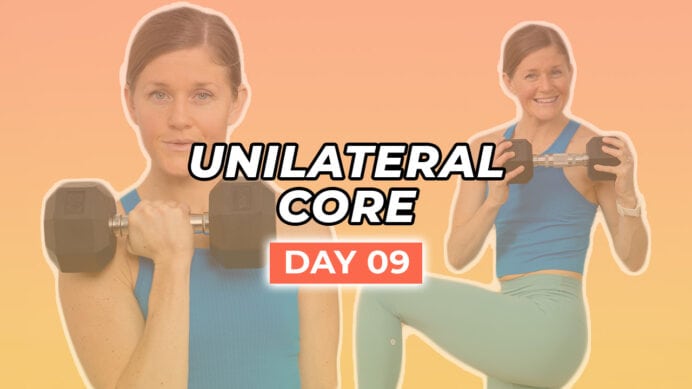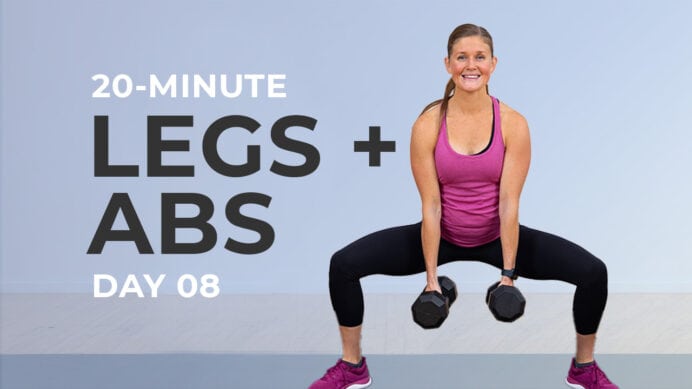
12 Unilateral Exercises for Full Body Strength
Improve muscle imbalances, reduce risk of injury, and increase total body strength with these unilateral exercises. I love to program unilateral movements into my workouts because they are incredibly functional: allowing us to target each side of the body evenly. Unilateral training exercises also engage the deep core stabilization muscles, making this a sneaky ab workout as well.
As a personal trainer with over a decade of experience, I believe that unilateral exercises are one of the most underrated “hacks” for building functional strength.
Most workouts focus on bilateral full body compound exercises, or exercises that use both sides of the body at once. Bilateral movements typically allow us to lift heavier, because there are more muscles assisting in the movement.
However, there are significant benefits to incorporating unilateral exercises, or single sided exercises, in our training routines:
- Balance and Stability: unilateral movements engage stabilization muscles in the core and hips, strengthening the deep ab muscles and improving balance.
- Correct Muscle Imbalances: although it’s normal to have a more dominant side, untreated muscle imbalances can lead to injury over time. Unilateral training forces each single limb to do the work, without allowing more dominant muscles to take over for the weaker side.
- Functional Strength: unilateral exercises are extremely functional because they mimic many of our daily movements.
- Non-Traditional Core Work: unilateral training is one of the best ways to build core strength and ab definition – no boring crunches needed. The most effective standing core exercises are unilateral by nature.
- Progressive Overload: shifting to single-limb movements is a great way to increase your workout intensity if you don’t have access to heavier weights.
Today’s workout is a mix of single leg exercises, unilateral arm exercises, and full body single-sided exercises.
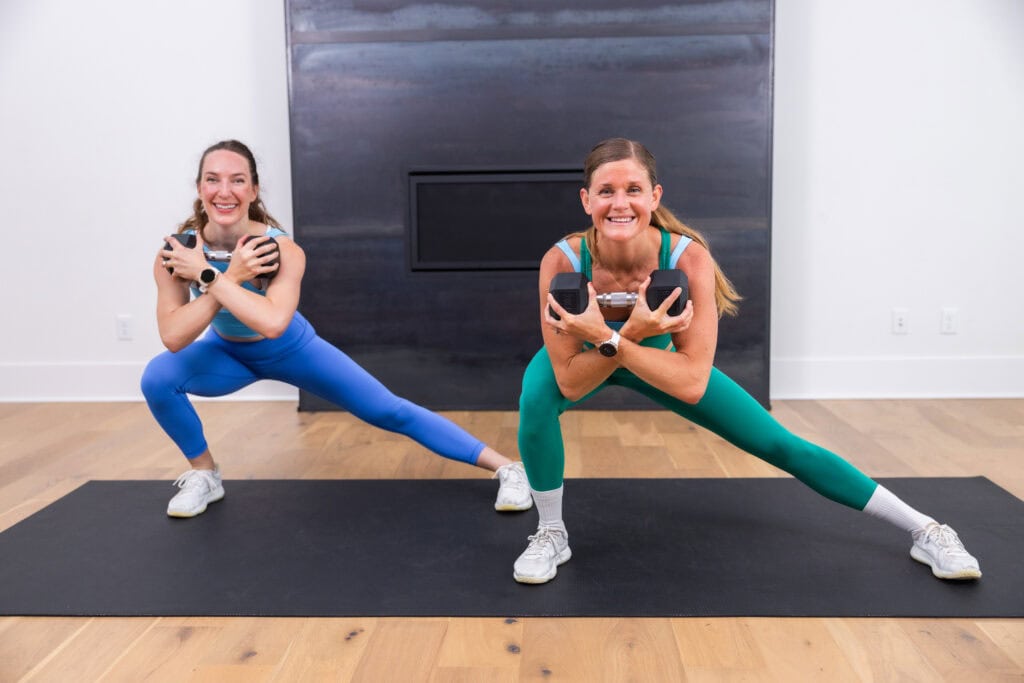
Unilateral Workout For Balance and Strength
Improve balance, prevent injuries, and increase overall strength and stability with this functional full body unilateral training session.
Add full body workouts at home like this to your muscle building workout plan one to two times a week to increase total body strength and endurance.
Workout Instructions:
Follow along with the guided Full Body Unilateral Workout on YouTube, led by certified personal trainer, Lindsey Bomgren.
Your Workout Looks Like This:
- 4 Circuits
- 3 Unilateral Exercises/Circuit (one upper body, one lower body, and one combination exercise)
- Timed Intervals (30 seconds work, 15 seconds rest)
- Repeat Each Circuit x2 Sets
Workout Equipment:
Medium Pair of Dumbbells. I recommend between 5-25 lbs depending on your fitness level. We used 15 and 20 lb dumbbells in today’s workout. Option to add a box or bench.

Prefer to Watch On YouTube?
Workout Outline
CIRCUIT ONE:
- Staggered Good Morning and Lateral Lunge
- Uneven Push Up and Shoulder Tap
- Staggered Stance Burpee and Single Arm Press
CIRCUIT TWO:
- Rear Foot Elevated Lunge
- Incline Plank and Single Arm Back Row
- Staggered Row, Clean and Curtsy Lunge
CIRCUIT THREE:
- Staggered Squat
- Single Arm Bicep Curl
- Staggered Squat and Eccentric Bicep Curl
CIRCUIT FOUR:
- Single Leg Glute Bridge
- Single Leg Bridge Hold and Skull Crushers
- Uneven Sit Up and Single Arm Press
Unilateral Exercises for Full Body Strength
Staggered Good Morning and Lateral Lunge
Targets: Glutes, outer glutes (gluteus medius), inner thighs, hamstrings, hips, quads, erector spinae, lower back and core muscles.

How To Do A Staggered Good Morning and Lateral Lunge
- Stand with feet hip-width apart, knees slightly bent. Hold one dumbbell horizontally at your chest or place it behind your head, resting on your upper back and shoulders. Hold each head of the dumbbell with one hand.
- Stagger your feet, so your left leg is slightly in front of your right foot. Kickstand your back right foot, right heel floating off the ground. Keep 80% of your weight in your front foot, 20% in your back right toe.
- Maintain a staggered stance as you hinge forward at the hips until your torso is parallel to the ground, or you feel a stretch in the hamstrings. This is a “good morning” exercise. Core is engaged and the spine is neutral, keeping the back flat.
- Press through your left heel to stand tall, returning to a standing position.
- Then, perform a lateral lunge by stepping your right leg out to the side as you push your hips back, bending your right knee while leaving your left leg straight. Think of performing a single leg squat with your right leg while your left leg remains straight. Knees and toes are pointing forward.
- Then, drive off your right foot to reverse the movement, pushing back to center and returning to a staggered stance.
Uneven Push Up and Shoulder Tap
Targets: Chest, shoulders, triceps, back, abs, obliques and core muscles.
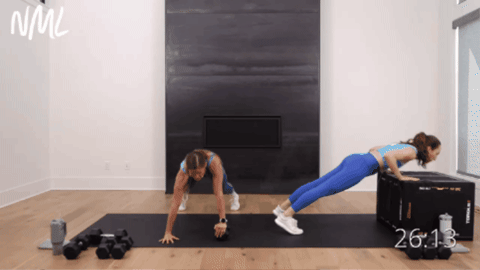
How To Do Uneven Push Ups and Shoulder Taps
- Start in a high plank position with your shoulders stacked over your wrists. Place your left hand on the head of a stable dumbbell. Feet hip-width apart.
- Hold this high plank position, maintaining a straight line with your body, gaze slightly in front of you.
- Slowly lower your chest down towards the ground as your elbows fall back towards your body (not out to the sides).
- Once at the bottom of your push up, exhale as you push back up into high plank position.
- Then, perform a single-sided shoulder tap by tapping the left shoulder with the right hand.
Modification: Option to take the push ups from your knees. You may pop to your toes for the shoulder tap, or take the shoulder tap from the knees as well. Alternatively, perform incline push ups by placing your hands on a chair or bench.
Staggered Stance Burpee and Single Arm Press
Targets: Upper body (chest, arms, back, shoulders), lower body (legs, glutes, hips) and core.

How To Do A Staggered Stance Burpee and Single Arm Press
- Start standing, feet shoulder-width apart, holding one dumbbell in your right hand at your side. Stagger your feet, so your left leg is slightly in front of your right foot.
- Bend your knees and drop your hips as you lower into a squat position, then place your left hand on the floor and your right hand on your dumbbell, directly in front of your feet.
- Shift your weight into your hands as you jump your feet back to softly land on the balls of your feet in a high plank position.
- Then, jump your feet up, landing outside your hands while finding the staggered stance again. Then drive through your left heel to stand tall, returning to starting position.
- As you stand tall, curl the dumbbell in your right hand up to shoulder height. Then perform a single arm overhead press by pressing the dumbbell overhead, locking out right bicep near right ear.
Modification: Perform a staggered squat and single arm press rather than a burpee.
Rear Foot Elevated Lunge
Targets: Legs, glutes, quads, hamstrings, hips and core.
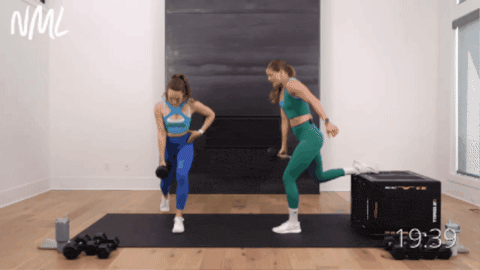
How To Do Rear Foot Elevated Lunges (Bulgarian Split Squats)
- Kneel in front of your bench or chair, then place your left foot behind you on a chair or bench, shoelaces down. You can place a towel under your foot to provide additional support if shoelaces down feels uncomfortable. Hold a dumbbell in your left hand.
- Step your right foot forward (it will vary for everyone, but a little over a foot in front of your bench). Your front thigh will be parallel to the ground. This is the bottom of your movement. Option to hold a dumbbell horizontally at your chest.
- Drive through your front right heel, squeezing your right glute to return to standing. Feel your front glute engage to power the movement.
- With control, bend your knee to lower down back to the starting position, making your front thigh parallel with the ground.
Modification: Perform a standard reverse lunge or split squat, keeping your back foot on the ground rather than elevating it on a chair.
Incline Plank and Single Arm Back Row
Targets: Latissimus dorsi (or lats), upper back, chest, shoulders, arms and core.
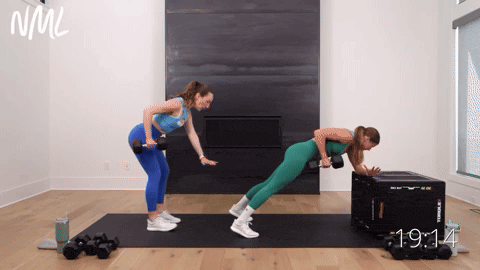
How To Do An Incline Plank and Single Arm Back Row
- Start in front of a bench, box or couch. Place one dumbbell on the ground below your right arm. Brace your left forearm horizontally on the bench, shoulder stacked over elbow. Then step both feet back, finding an elevated high plank position.
- Gripping the dumbbell in your right hand, pull your right elbow to your right hip (performing a renegade row, or plank back row).
- Slowly and with control, extend your arm, lowering your dumbbell towards the ground and returning to starting position.
Modification: Perform standing single arm bent over rows.
Staggered Row, Clean and Curtsy Lunge
Targets: Latissimus dorsi (lats), legs, quads (thighs) and gluteus maximus (butt), hip flexors and core.

How To Do A Staggered Back Row, Clean and Curtsy Lunge
- Stand with your feet slightly wider than shoulder-width apart, knees slightly bent. Find a staggered stance by stepping your left leg slightly behind your right leg. Hold a dumbbell in your left hand, palm facing in (narrow grip).
- Bend forward at the hips maintaining a flat back, as you pull the dumbbell back towards your left hip. Stop once your elbow is in line with your rib cage, making a straight line from shoulder to elbow. Hold the row at the top for a moment squeezing your shoulder blade in.
- With control, lower the dumbbell back to the starting position and drive through the front right heel to stand tall. As you stand tall, clean the dumbbell in your left hand to your left shoulder.
- Keeping the dumbbell at your left shoulder, step your left leg back into a curtsy lunge (left knee should meet right calf), left knee lowers towards the mat. Lower your hips until both knees reach a 90-degree angle, front thigh parallel to the floor.
- Drive through the right heel and glute to stand tall and repeat the sequence.
Staggered Squat
Targets: Legs, glutes, quads, hamstrings, hip flexors and core.

How To Do A Staggered Squat
- Stand with feet hip-width apart, knees slightly bent. Hold a pair of dumbbells at your sides, palms facing in. Stagger your feet, so your right leg is slightly in front of your left foot.
- Maintain a staggered stance as you perform a squat, lowering down into a squat position until hips are parallel with your knees. Drive your knees out toward your outer three toes.
- Drive through your front right heel to stand tall, squeezing your glutes and repeat.
Single Arm Bicep Curl
Targets: biceps brachii (the front of your arms). This move hits both heads of the biceps muscle.

How To Do Eccentric Single Arm Dumbbell Bicep Curls
- Stand with your feet slightly wider than shoulder-width apart, knees slightly bent.
- Hold a dumbbell in your right hand, palm facing away from your body.
- Keeping your right elbow locked by your side, squeeze your right bicep muscle to curl the weight up toward your right shoulder.
- With control, lower the dumbbell back to starting position. This is a slow deceleration of the weight through the full range of motion, lowering on a three-count in a controlled movement.
Staggered Squat and Eccentric Bicep Curl
Targets: Legs, glutes, quads, hamstrings, hip flexors, biceps and core.

How To Do A Staggered Squat and Eccentric Bicep Curl
- Stand with feet hip-width apart, knees slightly bent. Hold a pair of dumbbells at your sides, palms facing in. Stagger your feet, so your right leg is slightly in front of your left foot.
- Maintain a staggered stance as you perform a squat, lowering down into a squat position until hips are parallel with your knees. Drive your knees out toward your outer three toes.
- At the bottom of the squat, perform a single arm hammer curl on the right arm by curling the dumbbell up to shoulder height.
- Keep the dumbbell at shoulder height as you drive through your front right heel to stand tall. Then, slowly lower the dumbbell in your right hand down to your side on a three-count.
Single Leg Glute Bridge
Targets: Glutes, hamstrings, hips and pelvic floor.

How To Do Single Leg Glute Bridges
- Start laying on your back, right foot planted on the ground, left foot extended straight overhead, ankle stacked over knee.
- Press through your heels to lift your glutes off the mat, squeezing your glutes as you lift. Think about keeping your core engaged and knees in line with your hips.
- Exhale, slowly lowering your hips to hover an inch above the mat, returning to the starting position.
Modification: Perform a staggered stance glute bridge by planting your left heel and stepping your right foot out slightly further away from your body. Keep most of your weight in your left heel, right toes popped off the ground.
Single Leg Glute Bridge Hold and Skull Crusher
Targets: Legs, glutes, hamstrings, inner thighs, triceps (back of the arm) and core.

How To Do A Single Leg Glute Bridge Hold and Skull Crusher
- Start laying on your back, right foot planted flat on the ground, left foot extended straight overhead (ankle stacked over knee). Hold one dumbbell in each hand, fully extending your arms so the dumbbells are directly overhead, palms facing one another.
- Press through your heel to lift your glutes off the mat, squeezing your glutes as you lift. Think about keeping your core engaged and knees in line with your hips. Hold this single leg glute bridge.
- Bend at the elbows to slowly lower the dumbbells towards your head (just bending at the elbows). This is a skull crusher.
- Then push the dumbbells back overhead to return to the starting position. Repeat to perform as many skull crushers as possible in the timed interval, maintaining the single leg glute bridge hold the entire time.
Modification: Option to perform skull crushers while holding a staggered or double leg glute bridge (keeping both feet on the ground).
Uneven Sit Up and Single Arm Press
Targets: The rectus abdominis (your “six-pack” ab muscles), deep transverse abdominals, upper abs, lower abs, obliques and shoulders.

How To Do An Uneven Sit Up and Single Arm Press
- Start seated with knees bent and feet flat on the floor. Hold a dumbbell in your right hand at shoulder height.
- Keeping your core engaged, lean your torso back to lay flat on the ground, body forms a straight line.
- Pull your torso back to an upright position to perform a sit up. At the top of the movement, perform a single arm overhead press by pressing the dumbbell in your right hand directly overhead, locking out right bicep near right ear.
- With control, lower the dumbbell back to your shoulder, then lower back down to the mat and repeat.
Modification: Option to omit the sit up and perform seated crossbody chops and single arm overhead presses.
FAQs
Unilateral movement patterns, like lifting one leg at a time instead of both legs during exercises such as leg lowers, can generally be considered safer for diastasis recti than bilateral exercises. This is because they tend to put less pressure on the abdominal wall.
Yes, it’s common and normal for one side of the body to be stronger than the other. Most people naturally have a more dominant side, which means one side may be slightly stronger than the other. This can happen as a result of everyday habits (such as always holding a baby on the same hip) or natural biomechanics.
No. Although you may feel like you can lift heavier or perform more reps on your more dominant side, it’s not a good idea to increase workout load on one side. This can actually make imbalances worse, by strengthening the side that already is stronger than the other. Aim to work both sides evenly during both unilateral training and bilateral training.
More Workouts
Full Body WorkoutsPin This Workout: Benefits of Unilateral Training











